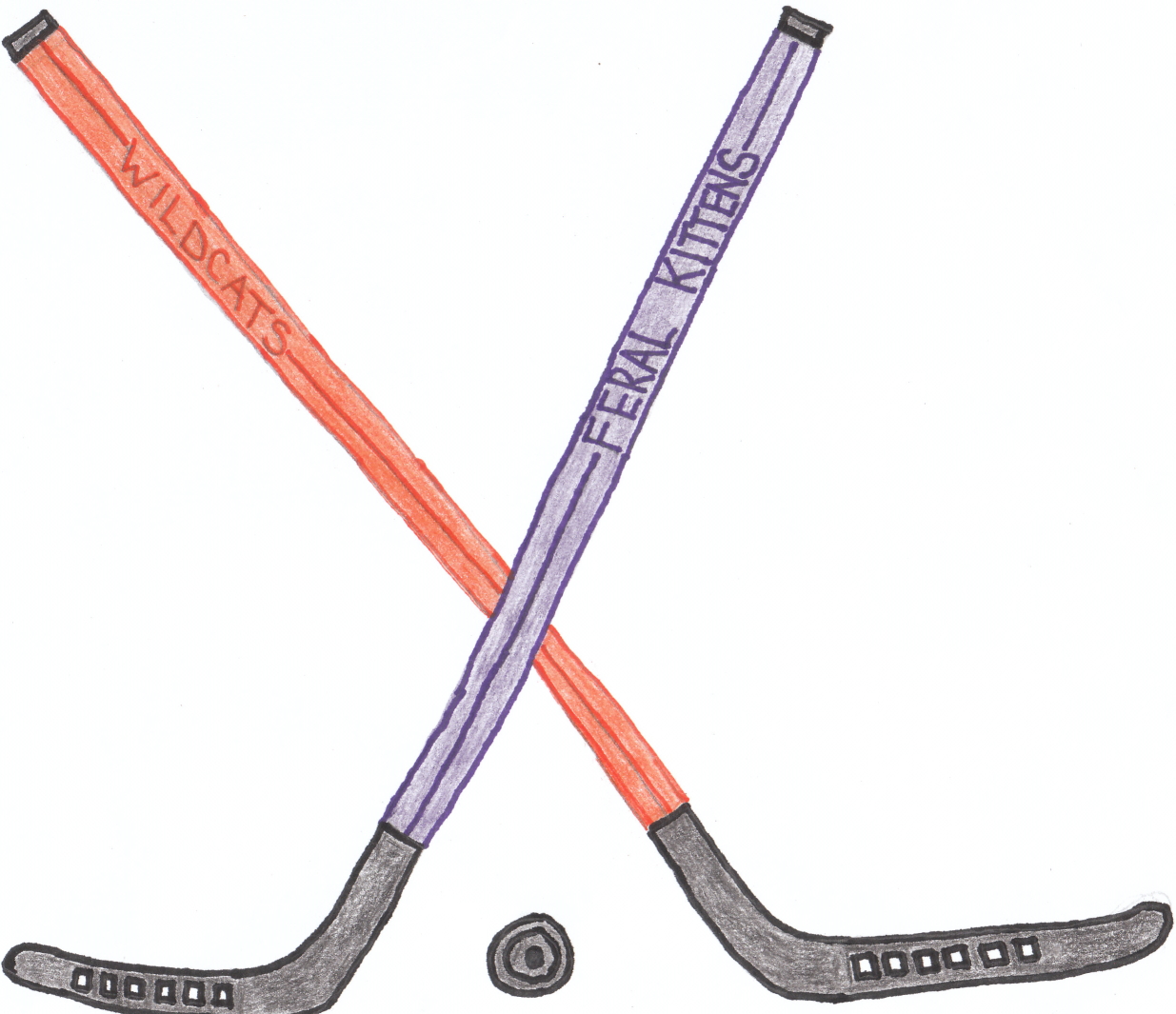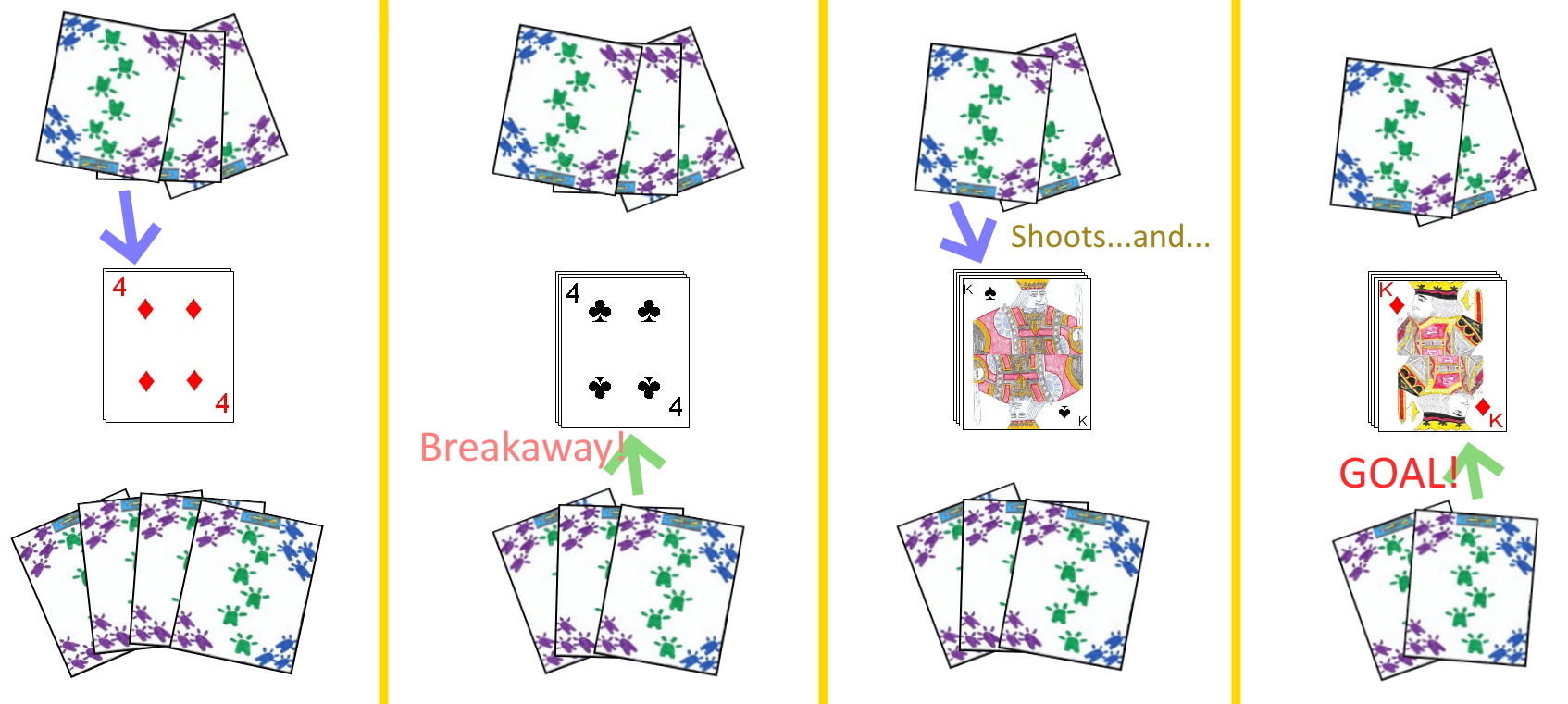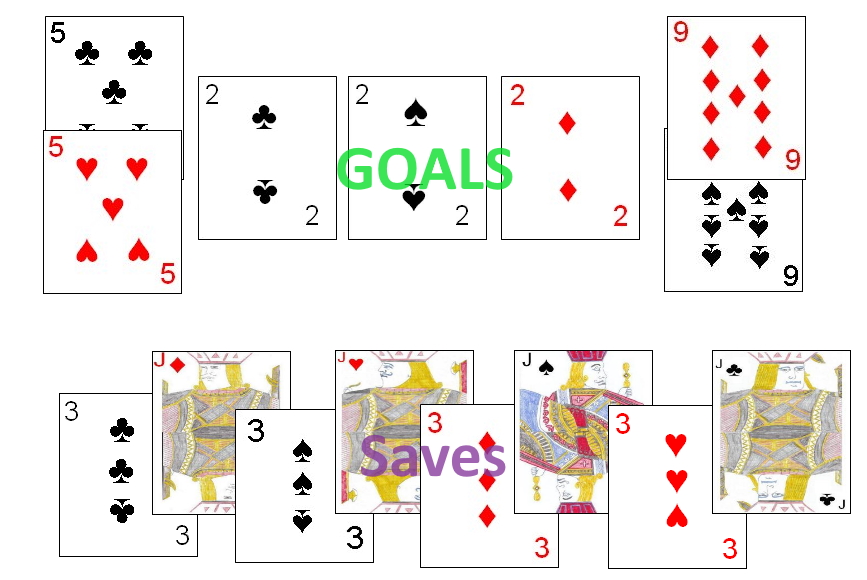How To Play Hockey
 Hockey is a fun, fishing type card game, developed in Canada in the very early 1960's. It is a two player game designed to simulate a game of Ice Hockey with each player representing one of the participating teams.
The card game Hockey is played using one standard 52 card deck. Most historical descriptions of the game attribute it to an invention by Hockey fan and card player Ida L. Spence. After it's invention, the game has rapidly spread to many other areas, particularly in
and around Canada.
Hockey is a fun, fishing type card game, developed in Canada in the very early 1960's. It is a two player game designed to simulate a game of Ice Hockey with each player representing one of the participating teams.
The card game Hockey is played using one standard 52 card deck. Most historical descriptions of the game attribute it to an invention by Hockey fan and card player Ida L. Spence. After it's invention, the game has rapidly spread to many other areas, particularly in
and around Canada.
Determination of the first dealer can be performed in a variety of ways, with cutting for high card a common method. Using this method each player draws a card from the shuffle deck and the player drawing the highest ranked card chooses whether they want to be the first dealer or they prefer their opponent to be the dealer on the first period. If both players draw cards of the same denomination, these cards should be discarded and both players draw another card. After each period, the role of dealer alternates amongst the two players.
The game is played over the course of three hands, known as Periods. However, at the end of these three Periods, if the game is tied, a fourth hand
(Period) is played as a tie-breaker.
During these first three hands, the dealer thoroughly shuffles the deck and offers it to his opponent to cut. After the cut, the dealer then deals five cards to each player, face down, starting with his opponent. He then sets the remainder of the deck, in a face-down pile to the side, for user later in the period. The opponent of the dealer plays the first card during the hand, and play alternates back and forth amongst the two players.
Each turn consists of a player selecting one card still remaining in his hand and playing it face-up to a central pile near the middle of the table. The first play of the hand will consist of playing to an empty pile, however after this first turn, each player will play his card to the one central pile.
 If a player manages to play a card to the table which is of the same rank as the card currently found on the top of the pile, this is called a breakaway, and entitles the player playing this matched card to possibly score on his next turn. After a
breakaway occurs, if the opponent of the player plays a third card of that same denomination, the break-away then shifts to that player instead. If a player plays the fourth card of that same denomination, the
breakaway would then shift back to the original player creating the
breakaway.
If a player manages to play a card to the table which is of the same rank as the card currently found on the top of the pile, this is called a breakaway, and entitles the player playing this matched card to possibly score on his next turn. After a
breakaway occurs, if the opponent of the player plays a third card of that same denomination, the break-away then shifts to that player instead. If a player plays the fourth card of that same denomination, the
breakaway would then shift back to the original player creating the
breakaway.
Once a player has created a breakaway situation, the player currently in control of the break-away has the opportunity to score a goal. A player scores a goal, if, that player has currently created a breakaway, and then that player is able to match the next card played by his opponent. As an example, say player 1 plays a four and player 2 also plays a four. This creates a
breakaway for player 2. Player 1 then plays a 9. If player 2 is able to play a 9, he scores a goal, earning him one point. Each goal scored by a player should be recorded on a
score sheet. If player 2 plays any other card, the breakaway is lost and the game continues as before the breakaway had been created.
In addition to a player creating such a breakaway by playing a card of the same denomination as the previous play, playing a Jack immediately creates a breakaway for the player playing the card. He may then try to match the next card played by his opponent, on his turn. However, if the opponent plays a Jack, the breakaway immediately shifts to that player instead. Thus, a Jack, anytime played on a player's legal turn, immediately creates a breakaway for the player of that card.
Gameplay continues in this manner until each player has completed play of the five cards dealt. At this point, the dealer then deals five more cards to each player from the still undealt portion of the deck. Play then continues exactly from where it had left, off, with any breakaways or potential goals still in effect. This will repeat four times, leaving 12 cards remaining in the deck. Thus, on the fifth distribution, each player will receive six cards instead of the usual five. Other than the greater number of cards, the final turns will play in the same manner.
After the entire deck has been dealt, this completes one period. At the end of each period, the cards are gathered and reshuffled for the next period. Any breakaways in progress are reset for the next period. The role of dealer then alternates to the other player, and this dealer deals for the next period. This continues for a total of three periods. After this time, the player with the higher number of scored goals is declared the game winner. However, if both players are tied, a fourth period is then played, called sudden death overtime.
If sudden death overtime is thus to be played, the role of dealer alternates as normal, and the cards are shuffled as normal. However, during this four overtime period, only four cards are dealt to each player during the first five deals. After these five deals, this will leave 12 cards remaining in the deck, so on the last deal of this overtime period, six cards are dealt to each player. The first player to score a goal during the sudden death overtime is declared the winner, with the game ending immediately. If, after completion of the overtime period, both players are still tied, the game is declared a tie.
In order to retain the theme and flavor of a Hockey game,
as well as add to the excitement, players often add a running commentary of the game. As a player creates a breakaway, he will announce "Breakaway", a player managing to score a goal will shout "Goal", and the opponent of a player who has just created a breakaway will say "Shoots". Other announcements can also occur if a player manages to avoid his opponent scoring, by playing a card that is just one rank different than the card played (saying "Hit the Post"), or if several cards difference in rank, would say "Save", or "Clears It" or "Clears the Ice" if playing a card that cannot be matched by his opponent after a breakaway by that opponent. Often additional colorful announcements and commentary ensues during the game.
Variations and Optional Rules
Original Rules: Since it's initial creation during the 1961
- 1962 Hockey season, the game has developed into the game as described above. However, in the first, original
rule set, there were a few differences, and some players still play using those original rules. This original version of the game is played identically as described in the rules described above, with the following two differences:
- In this version of the game, playing a Jack had no special play capability, and was similar to playing any other card. Thus, playing a Jack did not immediately create a breakaway for the player playing the Jack, unless a second Jack was played on an existing Jack, as would the case for playing any duplicate card.
- After a goal was scored, the player scoring the Goal was still considered to be in a breakaway situation, and thus, if able to again match the next card played by his opponent could score multiple goals in succession, if able to continue matching the cards played by his opponent.
Four Player Partnership Hockey: A four player variant of the card game Hockey also exists. In this somewhat simplified variant, the four players are divided into two teams consisting of two players each. Each player should sit directly across the table from his partner. The game also uses the same, 52 card deck as in the original two player variant.
In this variant, the entire deck is dealt out, thus the designated dealer, after shuffling and a cut, will deal out 13 cards to each player. The player to the immediate left of the dealer has the first play, and the turns rotate in a clockwise direction around the table. As in the two player
version described above, the game is played over the course of three hands (or periods). Traditionally, the player with four of clubs will start the game off, in the first period, playing this card to the center of the table, to begin the play pile. The turns then continue in a clockwise direction around the table, from player to player.
 On a turn, a player may select any card from his hand, playing it to the center of the table, directly on top of the previous play. If the player manages to play a card of the exact same rank as the current top card of the pile, that player's team scores one point (Goal). All cards from the play pile are then set aside out of play, and the next player in turn starts by playing any card from his hand to start a new play pile.
On a turn, a player may select any card from his hand, playing it to the center of the table, directly on top of the previous play. If the player manages to play a card of the exact same rank as the current top card of the pile, that player's team scores one point (Goal). All cards from the play pile are then set aside out of play, and the next player in turn starts by playing any card from his hand to start a new play pile.
There are also several card denominations that have special affects on gameplay if played to the center pile, as follows:
- Twos:
Any two played immediately scores a goal for the team of the player who played the two. The play pile is also cleared, being set aside, out of play.
- Threes, Jacks:
If a three or Jack is played to the pile, this is
called a Save. If a matching three or Jack is then also played to the table, this does not count as a Goal and does not clear the play pile. The next player in turn must then play any card from his hand, although playing a two on a three or Jack, still does count for a Goal, as normal.
After each hand, the cards are gathered together and the next dealer in a clockwise rotation deals the next hand. After the first period, one member of the team who has the lowest score plays the first card to start that period. If the teams are tied, the player with the four of clubs in hand plays this card to start the period.
After three of these periods have been completed, the team with the highest score is declared the game winner. If both teams have the same score after three periods of play, the game ends in a tie.
One unique feature of this game is that it is legal in this game for a player to attempt to view the cards of his opponents (called checking). He may not physically touch or bump the player (as is commonly done in Ice Hockey) to get a view of his cards, but he may crane his neck and alter his seating position to so view these cards. Thus, players are advised to attempt to keep their hand of cards close to the body.
Copyright © 2015
CatsAtCards.com. All rights reserved.
 Hockey is a fun, fishing type card game, developed in Canada in the very early 1960's. It is a two player game designed to simulate a game of Ice Hockey with each player representing one of the participating teams.
The card game Hockey is played using one standard 52 card deck. Most historical descriptions of the game attribute it to an invention by Hockey fan and card player Ida L. Spence. After it's invention, the game has rapidly spread to many other areas, particularly in
and around Canada.
Hockey is a fun, fishing type card game, developed in Canada in the very early 1960's. It is a two player game designed to simulate a game of Ice Hockey with each player representing one of the participating teams.
The card game Hockey is played using one standard 52 card deck. Most historical descriptions of the game attribute it to an invention by Hockey fan and card player Ida L. Spence. After it's invention, the game has rapidly spread to many other areas, particularly in
and around Canada.
 If a player manages to play a card to the table which is of the same rank as the card currently found on the top of the pile, this is called a breakaway, and entitles the player playing this matched card to possibly score on his next turn. After a
breakaway occurs, if the opponent of the player plays a third card of that same denomination, the break-away then shifts to that player instead. If a player plays the fourth card of that same denomination, the
breakaway would then shift back to the original player creating the
breakaway.
If a player manages to play a card to the table which is of the same rank as the card currently found on the top of the pile, this is called a breakaway, and entitles the player playing this matched card to possibly score on his next turn. After a
breakaway occurs, if the opponent of the player plays a third card of that same denomination, the break-away then shifts to that player instead. If a player plays the fourth card of that same denomination, the
breakaway would then shift back to the original player creating the
breakaway.
 On a turn, a player may select any card from his hand, playing it to the center of the table, directly on top of the previous play. If the player manages to play a card of the exact same rank as the current top card of the pile, that player's team scores one point (Goal). All cards from the play pile are then set aside out of play, and the next player in turn starts by playing any card from his hand to start a new play pile.
On a turn, a player may select any card from his hand, playing it to the center of the table, directly on top of the previous play. If the player manages to play a card of the exact same rank as the current top card of the pile, that player's team scores one point (Goal). All cards from the play pile are then set aside out of play, and the next player in turn starts by playing any card from his hand to start a new play pile.